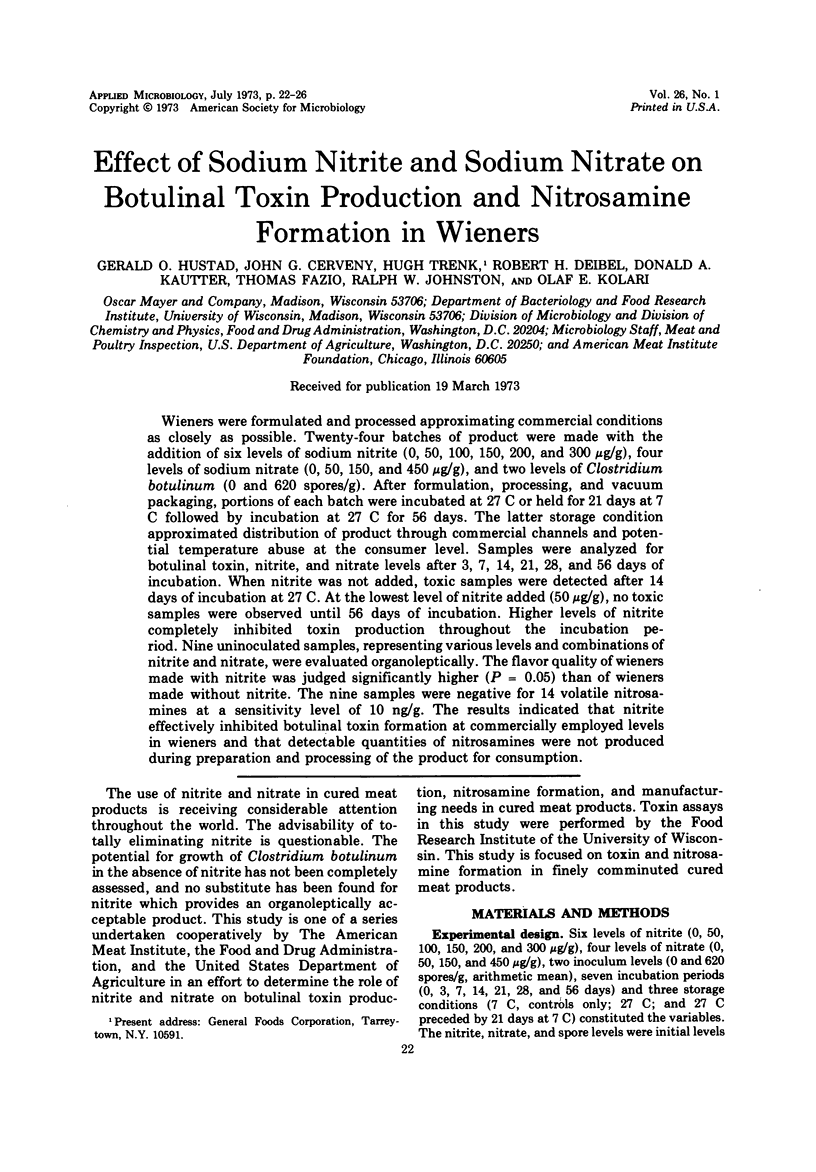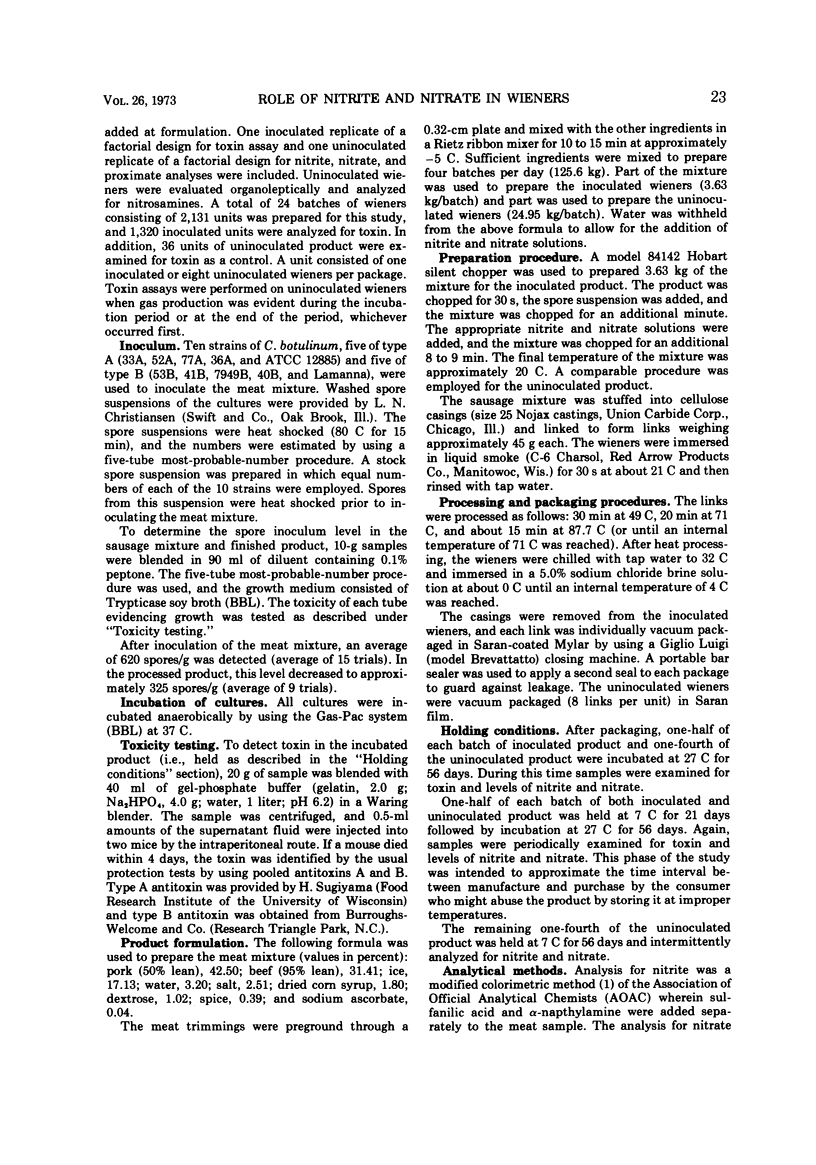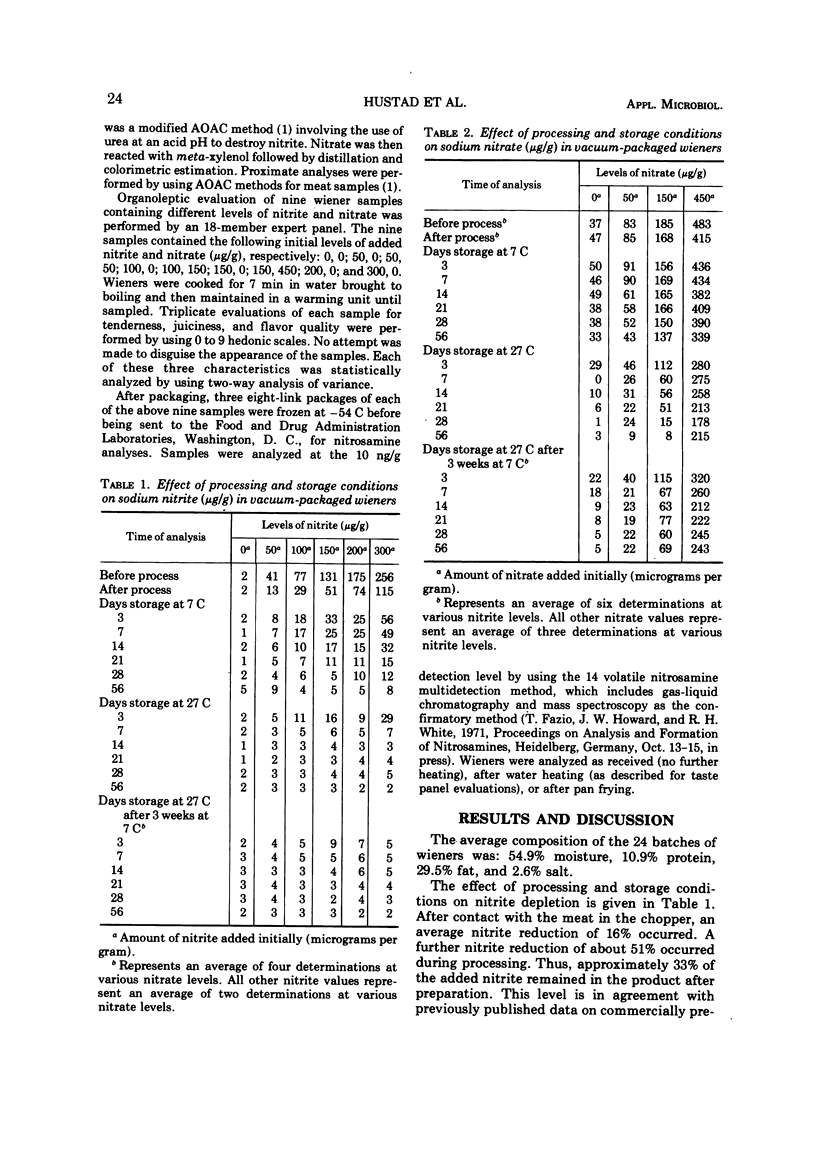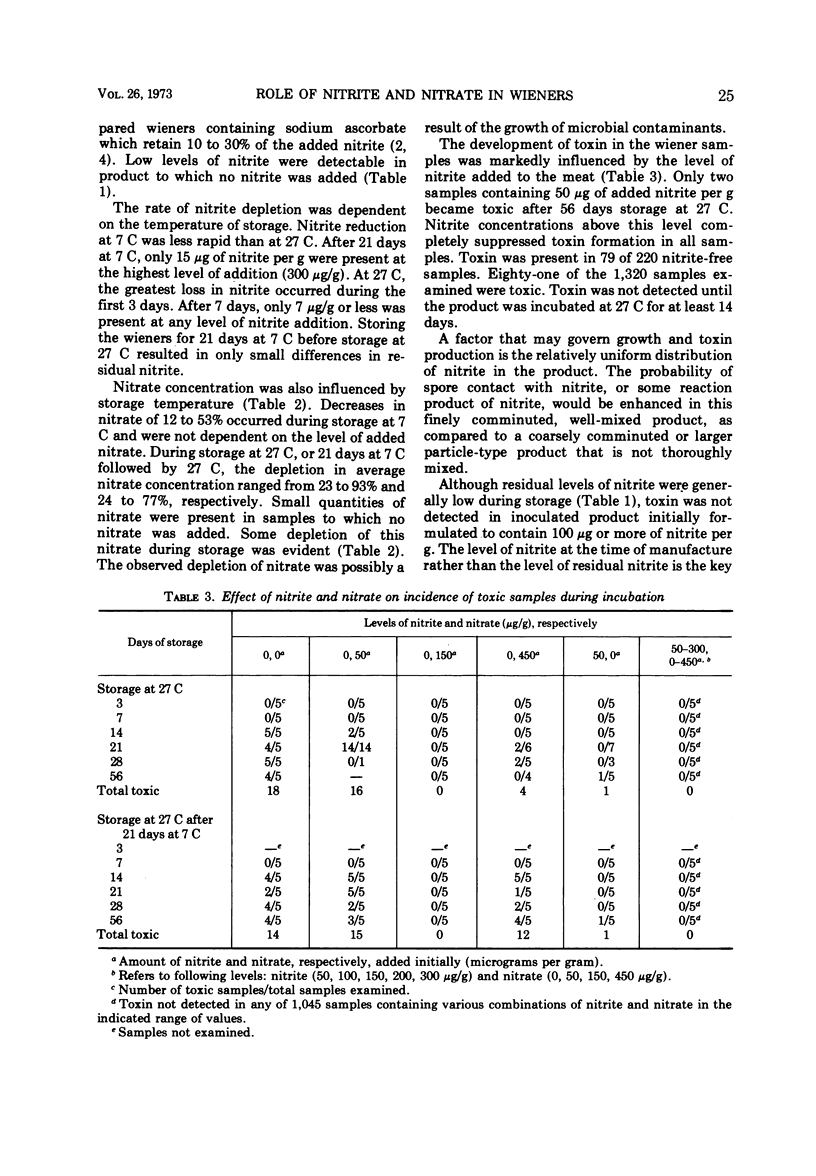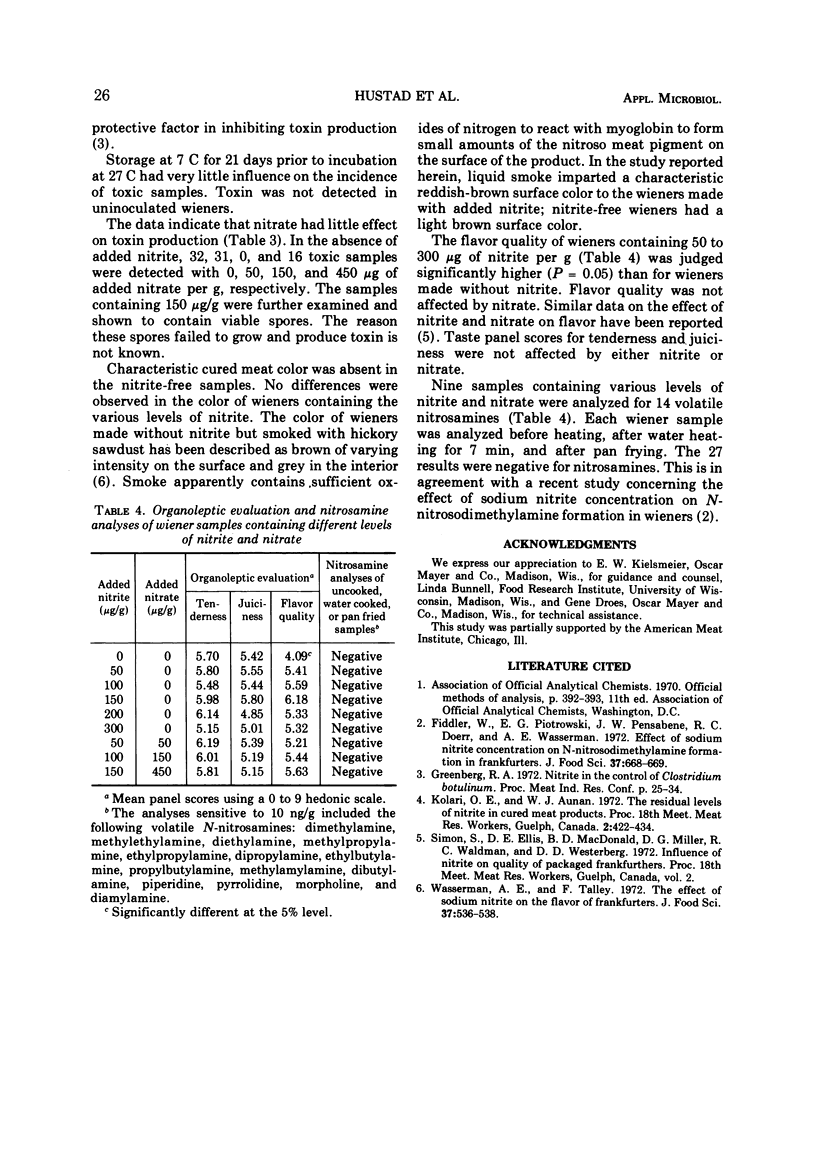Gerald O Hustad
Gerald O Hustad
1Oscar Mayer and Company, Madison, Wisconsin 53706
2Department of Bacteriology and Food Research Institute, University of Wisconsin, Madison, Wisconsin 53706
3Division of Microbiology, Food and Drug Administration, Washington, D.C. 20204
4Division of Chemistry and Physics, Food and Drug Administration, Washington, D.C. 20204
5Microbiology Staff, Meat and Poultry Inspection, U.S. Department of Agriculture, Washington, D.C. 20250
6American Meat Institute Foundation, Chicago, Illinois 60605
1,2,3,4,5,6,
John G Cerveny
John G Cerveny
1Oscar Mayer and Company, Madison, Wisconsin 53706
2Department of Bacteriology and Food Research Institute, University of Wisconsin, Madison, Wisconsin 53706
3Division of Microbiology, Food and Drug Administration, Washington, D.C. 20204
4Division of Chemistry and Physics, Food and Drug Administration, Washington, D.C. 20204
5Microbiology Staff, Meat and Poultry Inspection, U.S. Department of Agriculture, Washington, D.C. 20250
6American Meat Institute Foundation, Chicago, Illinois 60605
1,2,3,4,5,6,
Hugh Trenk
Hugh Trenk
1Oscar Mayer and Company, Madison, Wisconsin 53706
2Department of Bacteriology and Food Research Institute, University of Wisconsin, Madison, Wisconsin 53706
3Division of Microbiology, Food and Drug Administration, Washington, D.C. 20204
4Division of Chemistry and Physics, Food and Drug Administration, Washington, D.C. 20204
5Microbiology Staff, Meat and Poultry Inspection, U.S. Department of Agriculture, Washington, D.C. 20250
6American Meat Institute Foundation, Chicago, Illinois 60605
1,2,3,4,5,6,1,
Robert H Deibel
Robert H Deibel
1Oscar Mayer and Company, Madison, Wisconsin 53706
2Department of Bacteriology and Food Research Institute, University of Wisconsin, Madison, Wisconsin 53706
3Division of Microbiology, Food and Drug Administration, Washington, D.C. 20204
4Division of Chemistry and Physics, Food and Drug Administration, Washington, D.C. 20204
5Microbiology Staff, Meat and Poultry Inspection, U.S. Department of Agriculture, Washington, D.C. 20250
6American Meat Institute Foundation, Chicago, Illinois 60605
1,2,3,4,5,6,
Donald A Kautter
Donald A Kautter
1Oscar Mayer and Company, Madison, Wisconsin 53706
2Department of Bacteriology and Food Research Institute, University of Wisconsin, Madison, Wisconsin 53706
3Division of Microbiology, Food and Drug Administration, Washington, D.C. 20204
4Division of Chemistry and Physics, Food and Drug Administration, Washington, D.C. 20204
5Microbiology Staff, Meat and Poultry Inspection, U.S. Department of Agriculture, Washington, D.C. 20250
6American Meat Institute Foundation, Chicago, Illinois 60605
1,2,3,4,5,6,
Thomas Fazio
Thomas Fazio
1Oscar Mayer and Company, Madison, Wisconsin 53706
2Department of Bacteriology and Food Research Institute, University of Wisconsin, Madison, Wisconsin 53706
3Division of Microbiology, Food and Drug Administration, Washington, D.C. 20204
4Division of Chemistry and Physics, Food and Drug Administration, Washington, D.C. 20204
5Microbiology Staff, Meat and Poultry Inspection, U.S. Department of Agriculture, Washington, D.C. 20250
6American Meat Institute Foundation, Chicago, Illinois 60605
1,2,3,4,5,6,
Ralph W Johnston
Ralph W Johnston
1Oscar Mayer and Company, Madison, Wisconsin 53706
2Department of Bacteriology and Food Research Institute, University of Wisconsin, Madison, Wisconsin 53706
3Division of Microbiology, Food and Drug Administration, Washington, D.C. 20204
4Division of Chemistry and Physics, Food and Drug Administration, Washington, D.C. 20204
5Microbiology Staff, Meat and Poultry Inspection, U.S. Department of Agriculture, Washington, D.C. 20250
6American Meat Institute Foundation, Chicago, Illinois 60605
1,2,3,4,5,6,
Olaf E Kolari
Olaf E Kolari
1Oscar Mayer and Company, Madison, Wisconsin 53706
2Department of Bacteriology and Food Research Institute, University of Wisconsin, Madison, Wisconsin 53706
3Division of Microbiology, Food and Drug Administration, Washington, D.C. 20204
4Division of Chemistry and Physics, Food and Drug Administration, Washington, D.C. 20204
5Microbiology Staff, Meat and Poultry Inspection, U.S. Department of Agriculture, Washington, D.C. 20250
6American Meat Institute Foundation, Chicago, Illinois 60605
1,2,3,4,5,6
